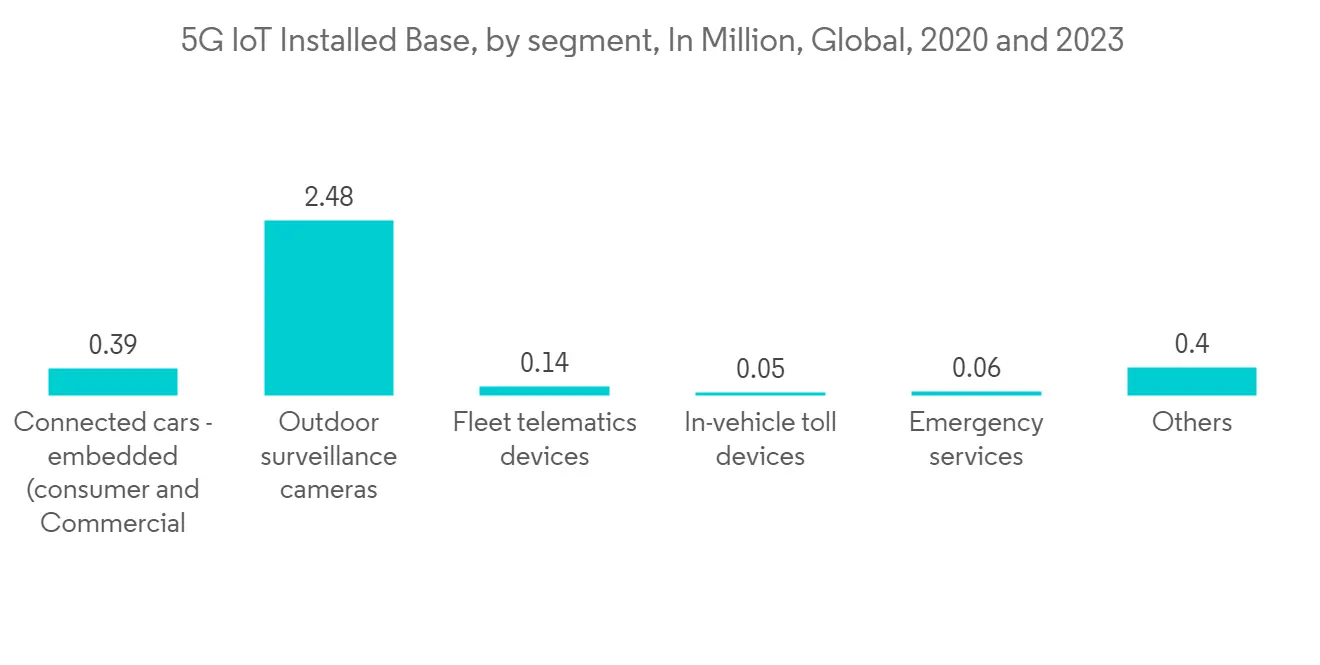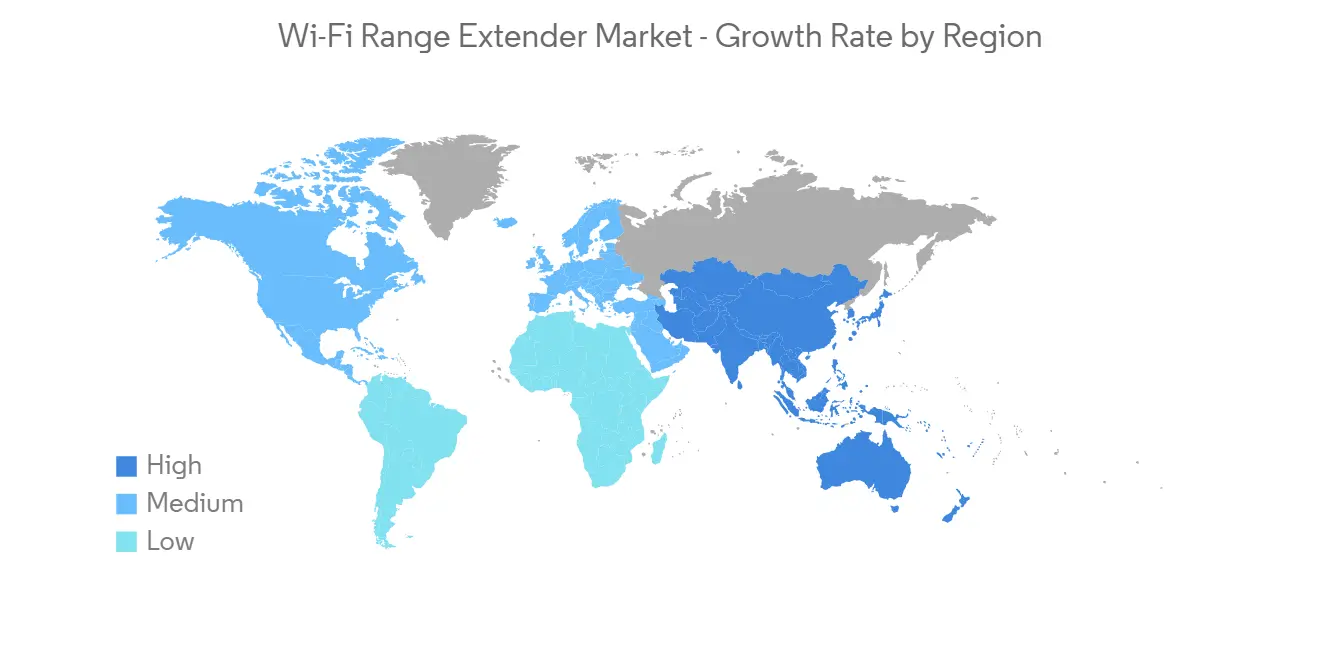 |
市場調查報告書
商品編碼
1273549
Wi-Fi 範圍擴展器市場 - 增長、趨勢、COVID-19 影響和預測 (2023-2028)Wi-Fi Range Extender Market - Growth, Trends, and Forecasts (2023 - 2028) |
||||||
※ 本網頁內容可能與最新版本有所差異。詳細情況請與我們聯繫。
在預測期內,Wi-Fi 範圍擴展器市場預計將以 10.8% 的複合年增長率增長。
由於對互聯網訪問的需求不斷增長以及全球家用電器的增加,預計該市場在預測期內將出現強勁增長。
主要亮點
- Wi-Fi 範圍擴展器比添加 Wi-Fi 路由器更容易安裝並且更具成本效益,因此它們對擴大銷售(主要是在商業和住宅領域)做出了重大貢獻。
- 智能家居生態系統的迅速普及和智能家居生態系統的出現預計也將推動市場增長。 此外,消費者越來越喜歡在家中安裝智能設備,例如智能電視、智能手機、平板電腦以及許多其他消費電子產品,這增加了對無線路由器的需求。
- 企業中 BYOD 趨勢的出現進一步推動了無線路由器在商業空間中的使用。 消費電子、安全和安防行業的快速增長和發展形成了一種創造新經濟機會的格局。 因此,Wi-Fi 範圍擴展器的全球市場正在擴大。 對各種技術突破的認識不斷增長,極大地推動了對 Wi-Fi 範圍擴展器的市場需求。 定制化、特定於行業的測試服務、快速變化的趨勢和客戶偏好正在推動市場對 Wi-Fi 範圍擴展器的需求。
- 此外,據分析,與安裝智能設備相關的網絡安全問題日益受到關注,這將阻礙預測期內的市場增長。 默認情況下或弱 SSID、密碼和不安全的加密技術可能會破壞 Wi-Fi。 攻擊者可以使用默認憑據輕鬆訪問您的路由器。 強大的 Wi-Fi 密碼會讓黑客尋找更難進入您網絡的入口點。 嗅探和解密是黑客獲取網絡訪問權最常用的方法。 因此,分析了對網絡安全日益增長的擔憂,以限制預測期內的市場研究。
- 我們還目睹了員工使用個人 Wi-Fi 互聯網連接訪問公司網絡。 COVID-19 流行病帶來的這種不可預見的中斷增加了 Wi-Fi 範圍擴展器的採用,以保持企業和核心業務運營的正常運行。 此外,世界各地的各個部門都通過參與語音、視頻和物聯網設備等帶寬需求大的應用程序,從 COVID-19 流行病中恢復過來。 結果,隨著對 Wi-Fi 需求的增長,無線網絡變得過於擁擠,迫使相關的 IT 團隊限制應用程序性能。 由於智能家居和智能城市連接設備的使用增加,市場在大流行後蓬勃發展。
Wi-Fi 範圍擴展器市場趨勢
智慧城市和智能家居的普及推動市場增長
- 互聯家居概念的傳播和智能家居生態系統的出現預計將成為推動市場增長的其他因素。 此外,商業無線路由器在過去幾年中取得了長足的進步。 最好的型號具有雙頻和三頻連接以及許多其他功能,並且通常是更昂貴的企業級型號。 然而,在大型辦公空間中,路由器覆蓋一直是一個重大挑戰,擴展器和中繼器的進步有望提供可行的解決方案。
- 未來幾年,智慧城市預計將提升全球 Wi-Fi 範圍擴展器市場的發展潛力。 同樣,許多買家對開放式 Wi-Fi 網絡越來越感興趣,包括醫療保健、廢物和水管理、基礎設施管理、教育接入以及安全和安保。 此外,隨著對開放式Wi-Fi系統的需求增長,更多的Wi-Fi交換機將部署在公共場所,推動對區域覆蓋範圍更廣、網速更快的Wi-Fi交換機的需求增加。
- 智能城市和智能家居正在經歷巨大的發展,並正在改變現代生活。 智能家居是指引入智能產品/設備的房屋,如智能安防系統、智能娛樂系統、空調、智能電視等。 隨著智能家居設備銷量的飆升,預計 Wi-Fi 範圍擴展器市場將進一步增長。
- Wi-Fi Range Extender 用於擴展常規 Wi-Fi 路由器的範圍,因為智能家居/辦公室中使用的智能產品/設備需要連接到互聯網才能無縫工作。 由於技術創新、消費者興趣和可訪問性的提高,對智能產品的總體需求將會增加。
- 智慧城市由智能係統組成,例如智能交通系統、智能建築、智能水管理、智能廢物管理和一些物聯網設備,這些設備需要互聯網連接並可用於跟蹤資源。提供數據。 預計這將提振所研究的市場。
- 越來越多地採用物聯網設備,推動了 Wi-Fi 範圍擴展器的發展。 據 Apatative 稱,全球 5G 物聯網 (IoT) 端點市場預計將從 2020 年的 40 萬台快速發展到今年的 1910 萬台。 到今年年底,5G 物聯網安裝基數預計將達到 4900 萬台。 物聯網的出現以及消費者對購買可以通過互聯網連接運行和執行各種功能的各種小工具和可穿戴設備的偏好不斷變化,預計也將在預測期內推動無線路由器和相關市場的增長。這是有可能的。 隨著連接設備數量的增加,各個家庭對互聯網的需求也越來越大。

北美市場份額最大
- 北美是 Wi-Fi 範圍擴展器市場的先驅,預計將佔據最大份額。 Netgear 等供應商也在該地區擁有強大的立足點。
- 促進 Wi-Fi 範圍擴展器市場增長的一個關鍵因素是許多最終用戶越來越多地使用無線服務。 由於大量住宅用戶採用連接設備技術,Wi-Fi 範圍擴展器主要用於該地區。 大多數公司在全球推出或部署產品之前,先在該地區測試和推出他們的產品和服務。
- 此外,由物聯網 (IoT) 提供支持的聯網設備、系統和服務的增長正在創造巨大的機會和收益。 此外,美國消費者越來越多地將物聯網設備用於各種應用。
- 越來越多的消費者正在接受美國的智能家居環境,物聯網也在北美地區進一步擴展。 在北美,許多智能家居已經聯網。
- 該地區對物聯網的接受度越來越高,也極大地推動了受訪市場的發展。 此外,已經部署了諸如支持物聯網的醫療可穿戴溫度傳感器等設備,用於將數據遠程傳輸到中央監控系統。 醫務人員可以根據行為和閾值識別、發出信號並響應患者和房間。

Wi-Fi 範圍擴展器行業概覽
Wi-Fi 範圍擴展器市場高度分散,主要參與者包括 D-Link Corporation、Linksys Group Inc.、TRENDnet, Inc.、Shenzhen Tenda Technology 和 Cisco Systems Inc.。 市場參與者正在採取合作和收購等戰略來加強他們的產品陣容並獲得持續的競爭優勢。
- 2022 年 6 月,Shenzhen Tenda Technology推出了 MX6-3 AX1800,這是一款專為大家庭設計的全屋網狀 Wi-Fi 6 系統。 它是一個可擴展的網狀網絡,覆蓋多個 Wi-Fi 點,無縫填充 6000 平方英尺的區域。 MX6 的每個節點將自動相互連接,在您的家中構建去中心化網絡。 您只需添加更多節點即可輕鬆擴展您的 Wi-Fi 網絡。 所有節點均配備千兆端口,充分利用高速寬帶服務,提供流暢的 4K 視頻流。
其他福利:
- Excel 格式的市場預測 (ME) 表
- 3 個月的分析師支持
內容
第一章介紹
- 調查假設和市場定義
- 本次調查的範圍
第二章研究方法論
第 3 章執行摘要
第 4 章市場洞察
- 市場概覽
- 產業吸引力 - 波特五力分析
- 新進入者的威脅
- 買方/消費者議價能力
- 供應商的議價能力
- 替代品的威脅
- 競爭公司之間的敵對關係
- 價值鏈分析
- 技術快照
- 評估 COVID-19 對行業的影響
第 5 章市場動態
- 市場驅動因素
- 智能城市和智能家居的擴散
- BYOD(自帶設備)的普及
- 市場挑戰
- 引進成本高
- 安全和隱私問題
第 6 章市場細分
- 按類型
- 室內 Wi-Fi
- 室外 Wi-Fi
- 按產品分類
- 擴展器、中繼器
- 接入點
- 天線
- 最終用戶
- 住宅
- 商業設施
- 普通家庭
- 其他行業的最終用戶
- 按地區
- 北美
- 歐洲
- 亞太地區
- 拉丁美洲
- 中東和非洲
第七章競爭格局
- 公司簡介
- D-Link Corporation
- Linksys Group Inc.
- TRENDnet, Inc.
- Shenzhen Tenda Technology Co.,Ltd.
- Cisco Systems Inc.
- Huawei Technologies Co. Ltd
- NETGEAR Inc.
- Aruba Networks(Hewlett Packard Enterprise Development LP)
- TP-Link Technologies Co. Ltd
- Juniper Networks Inc.
- Ruckus Wireless Inc.
- Motorola Solutions Inc.
第八章投資分析
第九章市場潛力
The Wi-Fi range extender market is expected to register a CAGR of 10.8 % during the forecast period. The market is expected to witness robust growth over the forecast period due to the growing demand for internet access and the increasing number of consumer electronics devices globally, primarily in the residential sector.
Key Highlights
- The ease of installation and cost benefits associated with the purchase of an extender compared to adding another Wi-Fi router, essentially performing the same function of extending the Wi-Fi coverage, is a significant advantage that plays a vital role in increasing the sales of the Wi-Fi range extenders, mainly in the commercial and residential sectors.
- The rapid growth of connected homes and the emergence of the smart home ecosystem are other factors expected to boost the market's growth. Additionally, the demand for wireless routers is rising from the growing consumer preference toward installing smart devices in the homes, such as smart TVs, smartphones, and tablets, among many other appliances.
- The emergence of the BYOD trend in the corporate sector has further propelled the use of wireless routers in the commercial space. The rapid growth and development of the consumer electronics, safety, and security industries have developed a pattern that is creating new economic opportunities. As a result, the global market for Wi-Fi range extenders is expanding. Growing knowledge of different technological breakthroughs significantly boosts market demand for Wi-Fi range extenders. Customization, industry-specific testing services, fast-changing trends, and customer preferences drive the market demand for Wi-Fi range extenders.
- Moreover, the growing cybersecurity concerns with the inclusion of smart devices are analyzed to hamper the market growth during the forecast period. Wi-Fi can be attacked by default or weak SSIDs or passwords and insecure encryption techniques. The attacker can easily access the router using the default credentials. Strong Wi-Fi passwords make hackers search for more challenging entry points to the network. The most typical methods used by hackers to access networks are sniffing and encryption breaking. Therefore, the growing cybersecurity concerns are analyzed to restrain the market studied during the forecast period.
- Employees have also been witnessed accessing the company network using personal Wi-Fi internet connections. This unexpected interruption caused by the COVID-19 epidemic increased the adoption of the Wi-Fi range extender to keep companies and key operations running. Furthermore, various sectors throughout the globe recovered from the COVID-19 epidemic by participating in bandwidth-hungry applications, including voice, video, and IoT devices. As a result, as demand for Wi-Fi grows, wireless networks become oversubscribed, forcing associated IT teams to limit application performance. With the increased use of connected devices for smart homes and smart cities, the market is growing rapidly post-pandemic.
Wi-Fi Range Extender Market Trends
Proliferation of Smart Cities and Smart Homes Drives the Market Growth
- The proliferation of the connected homes concept and the advent of the smart home ecosystem are other factors expected to augment the market's growth. Moreover, wireless routers targeted at businesses have improved tremendously over the past few years. The best models offer dual or triple-band connectivity and many other features, usually in far more expensive enterprise-grade models. However, the range of routers has always been a major challenge for large office spaces, and the evolution of extenders and repeaters has shown promise to provide a viable solution.
- In the coming years, smart cities are projected to fuel the global Wi-Fi range extender market's development potential. Similarly, this increased interest in open Wi-Fi networks from many purchasers, including healthcare, waste and water management, infrastructure management, educational access, and safety and security. Furthermore, as the need for open Wi-Fi systems increases, more Wi-Fi switches would be deployed in public locations, boosting the demand for Wi-Fi switches with a broader zone scope and faster Internet speeds.
- Smart cities and smart homes are growing tremendously and transforming modern life. A smart home is a residence that has installed smart products/devices, such as smart security systems, smart entertainment systems, air conditioners, smart televisions, and many more devices. With the rapid increase in the sales of smart home devices, the Wi-Fi range extender market is poised to grow further.
- Smart products/devices used in smart homes/offices must be connected to the internet to work seamlessly and, thus, require Wi-Fi range extenders for an increased range of a normal Wi-Fi router. The overall demand for smart products is poised to increase owing to technological innovations, consumer interest, and greater accessibility.
- A smart city consists of smart systems, like smart traffic systems, smart buildings, smart water management, smart waste management, and a couple of IoT devices, among others, which need an internet connection to provide useful data to keep track of the resources. This is expected to boost the market studied.
- The increasing adoption of IoT devices is augmenting the growth of Wi-Fi range extenders. According to Apatative, The global 5G Internet of Things (IoT) endpoint market is expected to develop rapidly, from 0.4 million units in 2020 to 19.1 million units in the current year. The 5G IoT installed base is expected to reach 49 million by the end of the current year. The advent of IoT and changing consumer preferences towards purchasing various gadgets and wearables capable of operating and performing various functions with internet connectivity is also set to propel the wireless routers' growth and associated markets over the forecast period. The demand for the internet among various households has been increasing with the growth in connected devices.

North America to Hold the Largest Market Share
- North American region is a pioneer in the Wi-Fi range extender market and is expected to hold the largest share. Moreover, the region has a strong foothold of vendors like Netgear Inc.
- The major factor contributing to the growth of the Wi-Fi extender market is the rising utilization of wireless services among numerous end users. The Wi-Fi extender is majorly used in the region, owing to the large number of residential users adopting connected device technology. Most companies test and launch their products and services in the region before the global launch and deployment of the product.
- Further, the growth of network-connected devices, systems, and services using the Internet of Things (IoT) creates enormous opportunities and benefits. Moreover, US consumers are increasingly using IoT devices for various applications.
- Also, with the rising number of consumers embracing the smart home environment in the United States, IoT is further expanding across the North American region. Many smart homes have already been connected to North America.
- The growing acceptance of IoT in the region is also significantly driving the studied market. Furthermore, devices such as IoT-enabled medical wearable temperature sensors to remotely transmit data to a central monitoring system are already in deployment mode. Medical staff is signaled based on trends and thresholds, identifying the patient and room, and can respond accordingly.

Wi-Fi Range Extender Industry Overview
The Wi-Fi Range Extender Market is highly fragmented with the presence of major players like D-Link Corporation, Linksys Group Inc., TRENDnet, Inc., Shenzhen Tenda Technology Co., Ltd., and Cisco Systems Inc. Players in the market are adopting strategies such as partnerships and acquisitions to enhance their product offerings and gain sustainable competitive advantage.
- In June 2022, The Shenzhen Tenda Technology Co., Ltd launched MX6-3 AX1800 a whole-home mesh Wi-Fi 6 system designed for larger households. It is an expandable mesh network that covers multiple Wi-Fi points and seamlessly fills up an area of 6000 square feet. Each node of MX6 automatically connects to each other, creating a distributed network throughout the home. Users can easily expand the Wi-Fi network just by simply adding more nodes. All nodes feature gigabit ports - that get the most out of the high-speed broadband service and ensure smooth streaming of 4K videos.
Additional Benefits:
- The market estimate (ME) sheet in Excel format
- 3 months of analyst support
TABLE OF CONTENTS
1 INTRODUCTION
- 1.1 Study Assumptions and Market Definition
- 1.2 Scope of the Study
2 RESEARCH METHODOLOGY
3 EXECUTIVE SUMMARY
4 MARKET INSIGHTS
- 4.1 Market Overview
- 4.2 Industry Attractiveness - Porter's Five Forces Analysis
- 4.2.1 Threat of New Entrants
- 4.2.2 Bargaining Power of Buyers/Consumers
- 4.2.3 Bargaining Power of Suppliers
- 4.2.4 Threat of Substitutes
- 4.2.5 Intensity of Competitive Rivalry
- 4.3 Value Chain Analysis
- 4.4 Technology Snapshot
- 4.5 Assessment of Impact of COVID-19 on the Industry
5 MARKET DYNAMICS
- 5.1 Market Drivers
- 5.1.1 Proliferation of Smart Cities and Smart Homes
- 5.1.2 Adoption of Bring-Your-Own-Device (BYOD)
- 5.2 Market Challenges
- 5.2.1 High Costs of Installation
- 5.2.2 Security and Privacy Concerns
6 MARKET SEGMENTATION
- 6.1 By Type
- 6.1.1 Indoor Wi-Fi
- 6.1.2 Outdoor Wi-Fi
- 6.2 By Product
- 6.2.1 Extenders and Repeaters
- 6.2.2 Access Points
- 6.2.3 Antennas
- 6.3 By End User
- 6.3.1 Residential
- 6.3.2 Commercial
- 6.3.3 Public
- 6.3.4 Other End-user Verticals
- 6.4 By Geography
- 6.4.1 North America
- 6.4.2 Europe
- 6.4.3 Asia Pacific
- 6.4.4 Latin America
- 6.4.5 Middle East and Africa
7 COMPETITIVE LANDSCAPE
- 7.1 Company Profiles
- 7.1.1 D-Link Corporation
- 7.1.2 Linksys Group Inc.
- 7.1.3 TRENDnet, Inc.
- 7.1.4 Shenzhen Tenda Technology Co.,Ltd.
- 7.1.5 Cisco Systems Inc.
- 7.1.6 Huawei Technologies Co. Ltd
- 7.1.7 NETGEAR Inc.
- 7.1.8 Aruba Networks (Hewlett Packard Enterprise Development LP)
- 7.1.9 TP-Link Technologies Co. Ltd
- 7.1.10 Juniper Networks Inc.
- 7.1.11 Ruckus Wireless Inc.
- 7.1.12 Motorola Solutions Inc.







